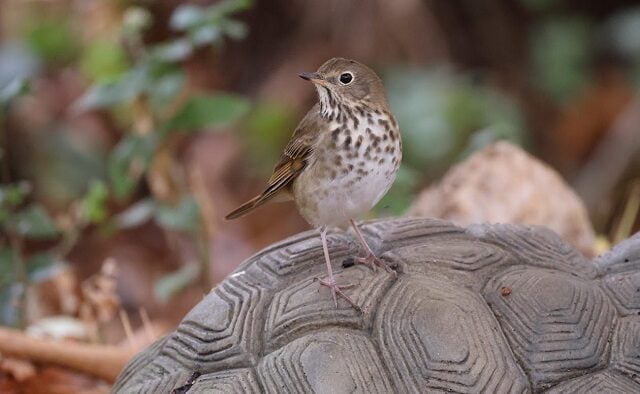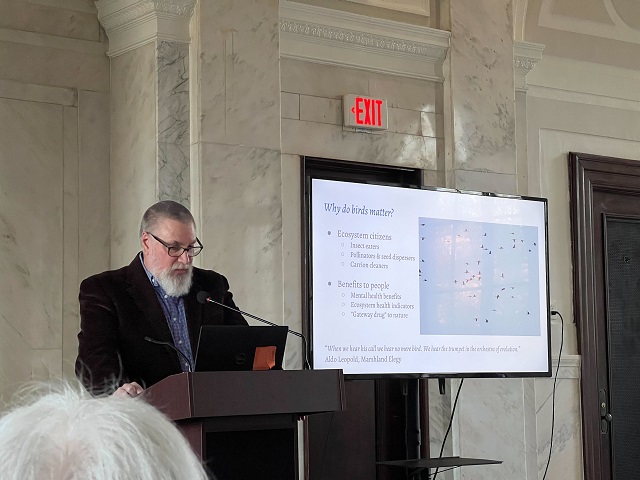Birds of Kirkwood project uncovers untold story of an early Atlanta birder
 A Hermit Thrush, photographed in the yard of Mike Ayling. Photo by Mike Ayling
A Hermit Thrush, photographed in the yard of Mike Ayling. Photo by Mike Ayling
This story has been updated.
By Grace Donnelly, contributor
Atlanta, GA – When Michael Ayling and his family moved into the house on Howard street in 2019, “the word ‘serendipity’ wasn’t really in my vocabulary,” he said.
Once he began researching the historic Victorian home, some happy coincidences started to accumulate. He realized he shared a passion, passed down to him by his own father, with the early Kirkwood resident whose daughter originally lived in the house: birding.
His curiosity about the story of the dwelling led to Robert Windsor Smith, who wrote an article published in 1903 titled “Birds of Kirkwood,” and who Ayling believes was the first ornithologist working in the Atlanta area.
What began with real estate records revealed a story about Atlanta, the Kirkwood neighborhood pre- and post-Civil War, one family’s challenges and triumphs, and one man’s dedication to cataloging local bird life.
Ayling has documented the history he’s uncovered on his Birds of Kirkwood blog and shared his findings at the DeKalb History Center on March 19. The full presentation can be viewed here.
“I was incredibly lucky. I felt this was too good of a story not to tell,” Ayling said. “I think it’s important for people to understand the history of their homes.”
Who was Robert Windsor Smith?
The Smith family moved to Atlanta in 1848, before the railroads were completed and when the total population was fewer than 2,600 people. They owned storefront properties on Whitehall Street (now Peachtree Street) in downtown, including the location that eventually became Rich’s Department Store. The young Robert described their new home as “virtually in the wilderness.”
During the Civil War, Robert Windsor Smith served briefly in the Confederate Army and Union soldiers burned down his father’s house on Whitehall Street. By 1890, Smith was finished with his post-war career as an express messenger. He moved to Kirkwood with his wife, Mary, and their surviving children.

Michael Ayling speaks at the DeKalb History Center in Decatur. Photo by Grace Donnelly
In his retirement, Smith grew fruit trees and observed the birds in Atlanta.
The real spark of American ornithology took place around the turn of the century, with the founding of many organizations and publications dedicated to birding, Ayling said. These included the American Ornitholoigist’s Union, founded in 1883; the Office of Economic Ornithology in the US Department of Agriculture (which later became the US Biological Survey), founded in 1885; and The National Audubon Society, founded in 1905.
Smith spent at least 15 years collecting lists and specimens of birds in the Atlanta region. He shared details on bird migration with the US Biological Survey and wrote multiple articles for The Wilson Bulletin between 1901 and 1905.
After his death in 1910, Smith’s widow gifted his collection of some 400 bird specimens to Emory University. Today, the Fernbank Science Center is home to about 185 of those specimens. Smith’s notebooks tracking birds and weather in Kirkwood across 12 years are now part of the collection at the University of Georgia’s Hargrett Rare Book & Manuscript Library.
Why does it matter?
For Ayling, the research project is not about putting one well-off white man from the post-Reconstruction Era on a pedestal.
Smith grew up with enslaved people in his father’s households and served in the Confederate Army. The larger birding community continues to reckon with racist legacies of figures like John James Audobon. Kirkwood’s own history is at times quite ugly, Ayling said, and its legacy is complicated.
“Legacy can also suggest an inheritance or a gift, passed down from one generation to another. In this sense, it’s that which a predecessor had ascribed value to—what mattered to them—and implies the value recipients of that gift can recognize in the present,” he said.
The gifts Smith passed down include a curiosity about birds, a snapshot of their vitality in Atlanta some 120 years ago, and a prescient call to protect the habitats of Kirkwood’s true original residents.
In 1901, Smith published a commentary on trees, saying, “[W]ithout any undue display of sentiment, the writer pleads for the preservation of the trees. One does not have to look very far ahead to see in the destruction of these grand old landmarks the gradual but certain extermination of the birds.”
Birds are important ecosystem citizens, eating insects, pollinating plants, dispersing seeds, and acting as health indicators for all the species within an ecosystem.
Unfortunately, we’re losing them at an alarming rate.
The North American bird population has decreased by nearly 30% in just the last 50 years, totaling almost 3 billion birds lost, according to a recent study. If the decline continues at this pace, will Atlantans 120 years from now encounter even today’s most common birds?
The biggest bird killers include habitat loss and collision with windows—two symptoms of urban development.
“Birds do matter, history matters, and what we do today matters,” Ayling said.
For those looking to learn more about how to help birds survive, he recommended following the work of Birds Georgia as well as three books: A Sand County Almanac by Aldo Leopold, The Home Place by J. Drew Lanham, and Nature’s Best Hope by Doug Tallamy.
Atlantans can take simple steps to help minimize the harm to birds: Don’t cut down trees unless you absolutely have to, don’t spray pesticides on your lawn to kill the bugs, and don’t use leaf blowers or clear away fallen leaves in the fall. Do plant native species of plants, and turn out your lights at night during migration season in the spring and fall.
Ayling and his wife, Lori, continue to cultivate a bird- and pollinator-friendly garden at the house on Howard Street—carrying on the legacy of Ray McGrath, who lived in the house before them.
This type of conservation can come at a cost in the City of Atlanta. It is illegal for homeowners to have “uncultivated vegetative growth exceeding a height of 18 inches,” according to the municipal code. McGrath had to go to court in 2014 to defend his biodiverse and wildlife-centered garden against anonymous complaints.
Just days after the talk at the DeKalb History Center, Ayling received a similar citation from the city.
Here is Ayling’s recent presentation delivered to an audience at the DeKalb History Center in Decatur.
Want Decaturish delivered to your inbox every day? Sign up for our free newsletter by clicking here.
If you appreciate our work on this story, please become a paying supporter. For as little as $10 a month, you can help us keep you in the loop about your community.
